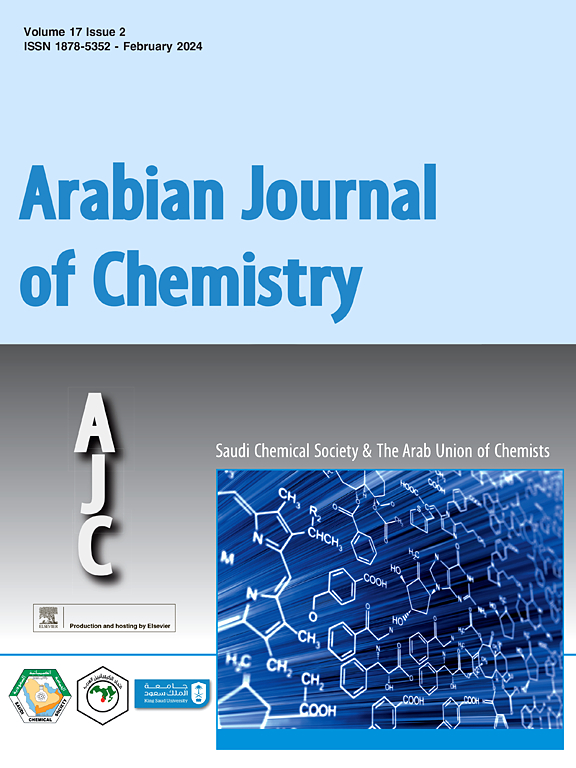Ultra-fine carbon decorated TiO2/C/g-C3N4 hybrid for strong physical adsorption and efficient photodegradation of pollutants
IF 5.3
2区 化学
Q2 CHEMISTRY, MULTIDISCIPLINARY
引用次数: 0
Abstract
Enhancement in the visible light absorption and efficient interfacial charge transfer is crucial for optimizing photocatalytic efficiency in the degradation of pollutants such as methyl orange (MO) and formaldehyde. This study focuses on the properties of a TiO2/C/g-C3N4 hybrid efficient photocatalyst, which is developed using an air calcination method to deposit graphitic nitride (g-C3N4) onto a carbon-modified TiO2 surface. The characterization techniques, including high-resolution transmission electron Microscopy (HRTEM), X-ray diffraction (XRD), Raman spectroscopy, thermogravimetric analysis (TGA), Fourier-transform infrared spectroscopy (FTIR), and X-ray photoelectron spectroscopy (XPS), were used to provide a comprehensive understanding of the material’s structural, morphological, thermal, and chemical properties. This hybrid catalyst is specifically engineered for the efficient decomposition of methyl orange (MO) and formaldehyde, demonstrating a significant increase in photocatalytic activity. The TiO2/C/g-C3N4 photocatalyst also exhibits an enhanced specific surface area of 181.2 m2/g, which facilitates increased physical adsorption and photo-catalytic active sites. Experimental results confirm that this catalyst effectively adsorbs MO physically even in the dark without degradation. Combining physical and photo-catalytic functions, this catalyst degrades 94 % of MO within 180 min with the initial concentration 0.2 mol/L of MO, and achieves almost 100 % decolorization of MO under visible light irradiation. Notably, the catalyst retains its high activity after 4 cycles of MO degradation, underscoring its durability and consistent performance. Additionally, the hybrid catalyst features a staggered type-II energy level configuration, which effectively enhances charge separation and boosts photocatalytic efficacy. The incorporation of an ultrafine carbon layer further augments electron mobility towards the surface, crucial for effective catalytic reactions. This study paves the way for future development of highly efficient photocatalytic materials for environmental purification.
用于强物理吸附和高效光降解污染物的超细碳装饰 TiO2/C/g-C3N4 混合物
在降解甲基橙(MO)和甲醛等污染物时,增强可见光吸收和高效的界面电荷转移对于优化光催化效率至关重要。本研究的重点是 TiO2/C/g-C3N4 混合高效光催化剂的特性,该催化剂采用空气煅烧法在碳修饰的 TiO2 表面沉积氮化石墨(g-C3N4)。表征技术包括高分辨率透射电子显微镜 (HRTEM)、X 射线衍射 (XRD)、拉曼光谱、热重分析 (TGA)、傅立叶变换红外光谱 (FTIR) 和 X 射线光电子能谱 (XPS),用于全面了解材料的结构、形态、热和化学特性。这种混合催化剂专为高效分解甲基橙(MO)和甲醛而设计,光催化活性显著提高。TiO2/C/g-C3N4 光催化剂的比表面积也提高到了 181.2 m2/g,这有利于增加物理吸附和光催化活性位点。实验结果证实,这种催化剂即使在黑暗中也能有效地物理吸附 MO 而不发生降解。该催化剂结合了物理和光催化功能,在初始浓度为 0.2 摩尔/升 MO 的情况下,可在 180 分钟内降解 94% 的 MO,并在可见光照射下实现几乎 100% 的 MO 脱色。值得注意的是,该催化剂在经过 4 次 MO 降解循环后仍能保持较高的活性,这表明它具有耐久性和稳定的性能。此外,该混合催化剂具有交错的 II 型能级配置,可有效增强电荷分离,提高光催化效率。超细碳层的加入进一步增强了电子向表面的流动性,这对有效的催化反应至关重要。这项研究为未来开发用于环境净化的高效光催化材料铺平了道路。
本文章由计算机程序翻译,如有差异,请以英文原文为准。
求助全文
约1分钟内获得全文
求助全文
来源期刊

Arabian Journal of Chemistry
CHEMISTRY, MULTIDISCIPLINARY-
CiteScore
10.80
自引率
3.30%
发文量
763
审稿时长
63 days
期刊介绍:
The Arabian Journal of Chemistry is an English language, peer-reviewed scholarly publication in the area of chemistry. The Arabian Journal of Chemistry publishes original papers, reviews and short reports on, but not limited to: inorganic, physical, organic, analytical and biochemistry.
The Arabian Journal of Chemistry is issued by the Arab Union of Chemists and is published by King Saud University together with the Saudi Chemical Society in collaboration with Elsevier and is edited by an international group of eminent researchers.
 求助内容:
求助内容: 应助结果提醒方式:
应助结果提醒方式:


